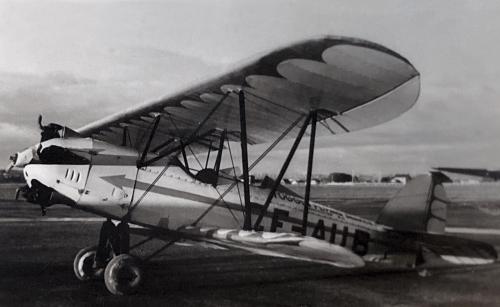by Brenda Ludwig
Leonard Foggin was born on February 24, 1905, in Thornaby-on-Tees, England. His parents were Henry (Harry) Bradley Foggin and his wife, Mildred Annie Barker. Harry Foggin was a butcher in the town of Thornaby-on-Tees, and also owned a farm.
Foggin’s Field
Fifty acres of Harry Foggin’s farm, along with parts of the Thornaby Grange, were taken to create an airfield near Middlesbrough (4 miles northeast of Thornaby-on-Tees). This site, opened as a stopover between Catherick and Marsk in 1914, became known as Foggin’s Field. Foggin’s Field was merely a large field with 2 corrugated sheet metal hangars and a few brick outbuildings. The control tower was a small hut with a large notice requesting visiting pilots to report there. That was enough, however, to capture young Leonard's imagination.
Life in Canada
Len came to Canada in 1927. He got a job working night shifts at the B.C. Electric Company gas works as a steam engineer. All his spare time he pursued his love of flight. He learned to fly at the old airport on Lulu Island in 1929, and he was one of the first members of the Aero Club of B. C. Len did not have a lot of money; he would take the streetcar to the airport and walk part of the way. He didn't take any vacations.

In April 1933, Len purchased a Kinner Bird BK biplane from M. Smith of Walla Walla, Washington. Registered as CF-AUB on May 2, 1933, it was all yellow with red scalloped leading edges on the wings and tail. It carried three people, the pilot in the rear with two passengers side by side in the front. Columbia Aviation would put their banner over Len’s Bird and pay Len a commission for the use of the plane. For maintenance he used the services of the Aero Club’s Bill Bolton.

In 1934, Len acquired the services of Larry Dakin as maintenance helper. Larry didn’t actually receive any money from Len until he got his engineer’s license in 1936. During the week Jack Wright did some instructing. The main source of income, however, was on the weekends, taking up passengers on Saturday and Sunday afternoons.

In 1936, Len Foggin acquired a Fleet 2 (CF-ANF) from A.H. Wilson and a DH.60M (Gypsy) Moth from Associated Air Service in Vancouver. The Gypsy Moth (CF-AGJ) was registered to Len on June 15, 1936. Foggin Flying Service was born.
Foggin Flying Service
Soon Foggin Flying Service was getting busy and it was starting to make a profit. When Len became a flying instructor in 1937, he finally decided to quit his job and to spend his time at the Foggin Flying Service.
Everyone who came to work for Len Foggin started work in maintenance. After they had spent some time in maintenance, and had acquired sufficient hours of flying time, the employees would start to fly aircraft. Larry Dakin would fly the Fleet 2 into logging camps on the weekends. On Saturday and Sunday, he would give rides. He would then fly back on Monday with $120 to $130 for a weekend's work. This became so profitable in 1937, Len decided to leave the plane on floats.
Early in 1938, Neil Cameron came to work for Len Foggin, first cleaning airplanes. Soon he began to work the fence on a commission basis, giving Foggin a real competitive edge.

In 1939 a Luscombe salesman came to the airfield. Neil made sure that Len Foggin met him. Len purchased a Luscombe 8A which he registered as CF-BNB on May 11, 1939, and shortly thereafter a second 8A registered as CF-BPA.
Len was now making lots of money with Foggin Flying Service. He bought a big car. He was a member of the Masons (Lodge No. 7, Mt. Herman). He was reputed to be a ladies man, who liked to party. Many people would borrow money from him.
The End of an Era
On May 13, 1941, Len and a former student, Jack Hawes, went up in his Fleet 2 biplane. Len was sitting in the front seat and Jack in the back. As this was a dual control plane, it is not known who was flying. About 45 minutes into the flight, while doing aerobatics over Boundary Bay, the plane suddenly went into a spin at 2000 feet, plummeted straight down, striking nose first and turning on its back with its wheels sticking up in the air, about a mile and a half from the shore. Len Foggin was killed instantly and Jack Hawes died about half an hour later.
Everyone was in shock that Len Foggin was dead. A telegram was sent to England to notify his parents of his death. Len was buried in the Masonic Cemetery in Burnaby, B.C.
Len’s long-term employee, Neil Cameron, wanted to continue Foggin Flying Service. However, the government had passed war-time legislation stating that no new flying schools could be started. If Neil had been a partner, he would have been able to continue the operation. He believed that Len had written a will giving the business to him. However, the will was never found.
